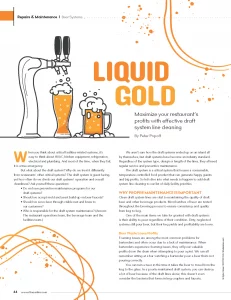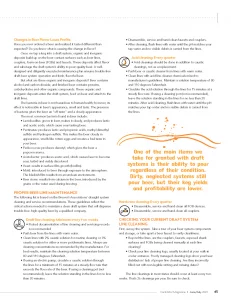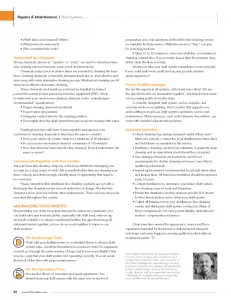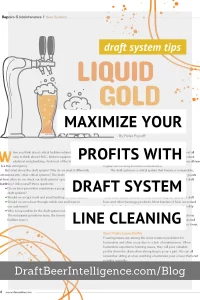One of our founders, Peter Popoff, recently wrote this article for Facilitator Magazine.
We post it here to showcase that the information you always see us writing about on the DBI blog or social media is genuinely timeless.
The message really never changes…draft system maintenance is critical to ensuring happy customers, increased profits and the best quality pours…pint after pint.
We hope you enjoy this article, and it answers some questions you may have about draft beer maintenance.
Here is the article: ‘Liquid Gold’ where you learn why draft system cleaning & maintenance is always a profitable decision.
Maximize Your Restaurant’s Profits With Effective Draft System Line Cleaning
When you think about critical facilities-related systems, it’s easy to think about HVAC, kitchen equipment, refrigeration, electrical and plumbing. And most of the time, when they fail, it is a true emergency.
But what about the draft system? Why do we treat it differently from restaurants’ other critical systems? The draft system is guest facing, yet how often do we check our draft systems’ operation and overall cleanliness? Ask yourself these questions:
- Do we have preventive maintenance programs for our draft systems?
- Should we accept mold and yeast build-up on beer faucets?
- Should we serve beer through visible rust and brass to our customers?
- Who is responsible for the draft system maintenance? (Answer: The restaurant operations team, the beverage team and the facilities team.)
We aren’t sure how the draft systems ended up on an island all by themselves, but draft systems have become an industry standard. Regardless of the system type, design or length of the lines, they all need regular service and preventive maintenance.
The draft system is a critical system that houses a consumable, temperature-controlled food product that can generate happy guests and big profits. So let’s dive into what needs to happen to add draft system line cleaning to our list of daily facility priorities.
Why Proper Maintenance Is Important
Clean draft system lines are vital to maintaining the quality of draft beer and other beverage products. Most batches of beer are tested throughout the brewing process to ensure consistency and quality from keg to keg.
One of the main items we take for granted with draft systems is their ability to pour regardless of their condition. Dirty, neglected systems still pour beer, but their keg yields and profitability are lower.
Beer Waste Loses Profits
Foaming issues are among the most common problems for bartenders and often occur due to a lack of maintenance. When bartenders experience foaming issues, they will pour valuable profits down the drain when attempting to pour a pint. We can all remember sitting at a bar watching a bartender pour a beer that’s not pouring correctly.
You can ruin a beer in the time it takes the beer to travel from the keg to the glass. In a poorly maintained draft system, you can destroy a lot of beer because of the draft lines alone; this doesn’t even consider the bacteria that forms in keg couplers and faucets.
Changes in Beer Flavor Loses Profits
Have you ever ordered a beer and realized it tasted different than expected? Do you know what is causing the change in flavor?
Once we tap a keg into a draft system, organic and inorganic deposits build up on the beer contact surfaces such as beer lines, couplers, foam-on-beer (FOBs) and faucets. These deposits affect flavor and sabotage the draft system’s ability to pour quality beer. A well designed and diligently executed maintenance plan ensures trouble-free draft beer system operation and fresh, flavorful beer.
But what are these organic and inorganic deposits? Beer contains alcohol and carbon dioxide, and finished beer contains proteins, carbohydrates and other organic compounds. These organic and inorganic deposits enter the draft system, feed on beer and attach to the draft lines.
The bacteria in beer is not hazardous to human health; however, its effect is noticeable in beer’s appearance, smell and taste. The presence of bacteria gives the beer an “off taste” and a cloudy appearance. The most common bacteria found in beer include:
- Lactobacillus: grows in beer, makes it cloudy, and produces lactic and acetic acids, which cause sour-tasting beer.
- Pectinatus: produces lactic and propionic acids, methyl dimethyl sulfide and hydrogen sulfide. This makes the beer cloudy in appearance, smells like rotten eggs and creates a foul taste in your beer.
- Pediococcus: produces diacetyl, which gives the beer a popcorn aroma.
- Acetobacter: produces acetic acid, which causes beer to become sour, turbid and visibly discolored. • Yeast: results in surface fi lm growth (biofilm).
- Mold: introduced to beer through exposure to the atmosphere. The blackish fi lm results from an unclean environment.
- Beer stone: results from calcium in the beer, introduced by the grains or the water used during brewing.
Proper Beer Line Maintenance
The following list is based on the Brewer’s Associations’ draught system cleaning and service recommendations. These guidelines reflect the critical actions needed to maintain a clean draft system that will dispense trouble-free, high-quality beer by a qualified company.
Draft line cleaning: Minimum every two weeks
- Posted documentation of line cleaning and servicing records is recommended
- Push beer from the lines with warm water.
- Clean lines with 2% caustic solution for routine cleaning or 3% caustic solution for older or more problematic lines. Always use cleaning concentrations recommended by the manufacturer. For best results, maintain the cleaning solution temperature between 80 and 110 degrees Fahrenheit.
- If using an electric pump, circulate a caustic solution through the lines for a minimum of 15 minutes at a steady fl ow rate that exceeds the fl ow rate of the beer. If using a cleaning pot (not recommended), leave the solution standing in the lines for no less than 20 minutes
- Disassemble, service and hand-clean faucets and couplers.
- After cleaning, flush lines with water until the pH matches your tap water and no visible debris is carried from the lines.
Acid cleaning: Every quarter
- Acid cleanings should be done in addition to caustic cleanings, not as a replacement.
- Push beer or caustic cleaner from lines with warm water.
- Clean lines with acid line-cleaner chemicals mixed to manufacturer’s guidelines. Maintain a solution temperature of 80 and 110 degrees Fahrenheit.
- Circulate the acid solution through the lines for 15 minutes at a steady fl ow rate. If using a cleaning pot (not recommended), leave the solution standing in the lines for no less than 20 minutes. After acid cleaning, flush lines with water until the pH matches your tap water and no visible debris is carried from the lines.
Hardware cleaning: Every quarter
- Disassemble, service and hand-clean all FOB devices.
- Disassemble, service and hand-clean all couplers.
One of the main items we take for granted with draft systems is their ability to pour regardless of their condition. Dirty, neglected systems still pour beer, but their keg yields and profitability are lower.
Checking Your Current Draft System Line Cleaning
First, survey the system. Take a tour of your beer system components and storage, or take apart a beer faucet to verify cleanliness.
- Beyond the lines, are the couplers, faucets, exposed shank surfaces and FOBs being cleaned manually at each line cleaning?
- Check your line cleaning logs, usually located at your walk-in cooler entrance. Poorly managed cleaning logs show your beer distributors’ lack of proper line cleaning. Are they incorrectly fi lled out with non-legible writing and missing dates?
The line cleanings in most states should occur at least every two weeks. That’s 26 cleanings per year. Be sure to check:
- Which lines were cleaned? When?
- What protocols were used?
- Who completed the work?
Understand the Chemicals
Strong chemicals, known as “caustics” or “acids,” are used to clean beer lines. Line cleaning removes bacteria, yeast, mold and beer stone.
Chemical contact and circulation times are essential to cleaning the beer lines. Cleaning chemicals contact the elements listed above, then dissolve and rinse away with water during the cleaning process. Mechanical cleanings are 80 times more effective than static cleaning.
These chemicals are hazardous and must be handled by trained personnel wearing proper personal protective equipment (PPE). Check to make sure your vendor uses cleaning chemicals at the “manufacturer recommended” specifications:
- Proper cleaning chemical mix ratio(s)
- Proper water temperature •
- Adequate contact time for the cleaning solution •
- Thoroughly rinse the draft system lines pre and post-cleaning with water
Flushing beer lines with beer is unacceptable and exposes your customers to cleaning chemicals in their beer. Be sure to consider:
- Does your vendor do a static clean for a minimum of 20 minutes?
- Do you receive mechanical clean for a minimum of 15 minutes?
- How does the beer taste after the line cleaning? Does it taste better, the same or worse?
Communicate Regularly with Your Vendors
Ask your beer line cleaning company or the beer distributor managing your account for a clear scope of work. Ask yourself whether they are cleaning your lines correctly and often enough. Identify areas of opportunity that need to be corrected.
Please remember that distributor line cleaning contracts are set with a third-party line cleaning vendor in most states free of charge. The free line cleaning service does not include other maintenance. These services are poorly executed throughout the country.
Maximizing Your Profits
By prioritizing one of the most important profit centers in a restaurant, you can build sales and increase profits, especially with draft beer, wine on tap and draft cocktails. I’ve always considered facilities the glue that brings all restaurant teams together, so how do we work together to improve our draft systems?
For the Beverage Team
Work with your facilities team on a scheduled basis to discuss draft system sales. Are there fl uctuations in your beer costs? Do restaurant A and B go through the same number of kegs, but B is more profi table? That may be a sign that your draft system isn’t operating correctly. You can avoid that most of the time with proper maintenance.
For the Operations Team
You are the drivers of execution and guest experience. You should treat your draft system with the same care as any food preparation area. Ask questions and hold the line cleaning vendor accountable for their service. While the service is “free,” you pay for your keg purchase.
It takes 15 to 20 minutes to clean one draft line, accounting for chemical contact time. If your vendor leaves after fi ve minutes, they didn’t clean the lines correctly.
Would you take your draft system maintenance more seriously if you could yield more profi t per keg and provide a better guest experience?
For the Facilities Manager
We are the experts in all systems, critical and non-critical. We are the glue that holds our restaurants together—but that doesn’t mean we’re pouring profits down the drain.
A correctly designed draft system can be complex, and you may not know everything. Find a vendor that supports you and is willing to teach you draft systems operation, service and maintenance. Many resources, such as the Brewers Association, can assist with essential educational resources.
Important reminders:
- Check cleaning logs during restaurant audits if they aren’t filled out correctly. Contact the local distributor for those lines and hold them accountable for the service.
- Distributor cleanings are the bare minimum. A quarterly deep cleaning and an operational check should be a standard. • Line cleaning chemicals are hazardous, and it’s not recommended to do line cleanings in-house. Leave this to qualified professionals.
- Annual replacement is recommended for all vinyl direct-draw and jumper lines. All main beer trunklines should be replaced every 10 years.
- Contact distributors to determine your state’s draft system line cleaning scope of work and frequency.
- Ensure the distributor and line cleaners provide SDS sheets for the chemicals they use to clean your draft system.
- Collect all insurance from your distributors, line cleaning vendor and third-party draft system contractors. Many of these companies do not carry proper liability, umbrella and workers’ compensation insurance.
Clean beer lines ensure the appearance, aroma and flavor experience intended by the brewer is delivered pint after pint. Let’s keep customers happy by serving quality beer that delivers maximized profits.
Check out this article in The Facilitator Magazine here.
Are You Ready To Increase Your Draft System’s Profits?
Here at Draft Beer Intelligence, we always want to help you deliver the perfect pour day after day. And to make sure that your draft beer systems produce GREAT tasting beer and MAXIMIZE profits!
Contact us here anytime if you need a draft beer system design, installation, ongoing maintenance, or service nationwide. Together, let’s keep “DOING BEER JUSTICE!”





